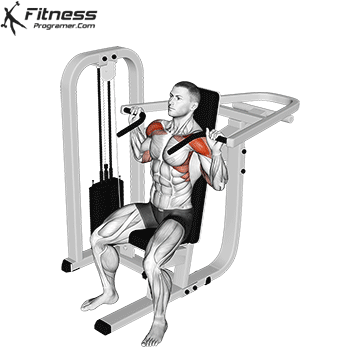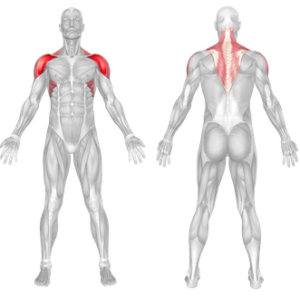Overview
The lever shoulder press is a machine-based strength training exercise designed to effectively target the shoulders, particularly the anterior (front) and lateral (side) deltoids. Unlike free-weight exercises, the lever shoulder press ensures a predetermined movement path, reducing the need for stabilization and allowing greater focus on isolating and developing the shoulder muscles.
How to Perform Lever Shoulder Press

Starting Position: Sit upright on the lever shoulder press machine, ensuring your back is firmly against the pad. Adjust the seat height so the handles are at shoulder level.
Grip and Alignment: Grasp the machine’s handles with an overhand grip. Your arms should be out to the side, facing forward, with your elbows positioned directly beneath your hands.
Pressing Movement: Press the handles upward by extending your elbows fully, pushing through your shoulders until your arms are straight overhead, but avoid locking your elbows completely.
Controlled Lowering: Slowly lower the handles back down to shoulder level, maintaining control and tension throughout the movement.
Repeat: Perform the exercise for 8–12 repetitions per set, ensuring smooth and controlled motions.
Tips for Proper Form:
Keep your back flat against the pad throughout the exercise.
Avoid locking elbows fully at the top position to maintain tension and protect joints.
Exhale during the upward pressing motion and inhale during the lowering phase.
Choose a manageable weight to maintain control and proper technique.
Common Mistakes :
Arching the Back: Excessive back arching can lead to lower-back strain; maintain proper alignment by engaging your core.
Using Excessive Weight: Too much weight often results in poor form and increased injury risk.
Partial Range of Motion: Not fully extending or lowering the handles limits muscle activation and overall effectiveness.
Benefits of the Lever Shoulder Press
Targets Shoulder Muscles Precisely: Effectively isolates anterior and lateral deltoids, maximizing muscular strength and development.
Controlled and Safe Movement: The lever system provides a predetermined path, reducing risk of injury due to instability or incorrect technique.
Ideal for Beginners and Rehabilitation: Its guided movement makes it safe and accessible for beginners or individuals recovering from shoulder injuries.
Enhances Shoulder Stability and Strength: Consistent practice improves shoulder joint stability, essential for overall shoulder health.
Improves Upper-Body Muscular Symmetry: Contributes to balanced development of shoulders, complementing chest and back exercises.
How to Incorporate Into Your Routine
For Beginners: Start with 2–3 sets of 10–12 reps, using lighter resistance to build technique and shoulder stability.
For Hypertrophy (Muscle Growth): Perform 3–4 sets of 8–12 reps, moderate-to-heavy resistance, focusing on muscle contraction and controlled pace.
For Strength Building: Include 4 sets of 6–8 reps with heavier resistance, resting approximately 2 minutes between sets.
For Rehabilitation: Perform 2–3 sets of 10–15 reps with light resistance, emphasizing controlled, pain-free movement.
For Functional or Circuit Training: Integrate the lever shoulder press into upper-body circuits, performing 8–12 reps per set with minimal rest.
Lever Shoulder Press: Muscles Worked

Frequently Asked Questions
Is the lever shoulder press suitable for beginners?
Yes, beginners benefit from the controlled motion and guided movement, allowing safer development of shoulder strength.
Can lever shoulder press replace free-weight shoulder presses?
While effective, combining lever presses with free-weight movements ensures comprehensive shoulder strength and stabilization.
How frequently should I perform lever shoulder presses?
Typically, incorporating this exercise into your routine once or twice per week provides optimal shoulder development.
Does this exercise strain the shoulder joints?
When performed with appropriate weight and proper form, this exercise minimizes joint stress compared to free weights.
